Last May, I found the lifeless body of a small, black and white bird lying among the tables and chairs in front of a restaurant along Washington DC’s Anacostia River waterfront. I stooped down and saw that it was a Blackpoll Warbler, with its diagnostic black cap, white cheek, and streaked chest, and then took a picture and carefully placed the bird in a zip-loc bag. As small as these birds’ bodies are, they feel lighter in your hand than you might expect, as their bulk is mostly made up of feathers. Blackpoll warblers weigh around 0.4 ounces, which is about as much as 10 jelly beans. Yet with these tiny bodies, they make an almost incomprehensible migration each fall, flying directly from New England to South America - a non-stop flight of 72 hours covering some 1,600 miles, all over the open ocean. This particular bird had completed that incredible journey the previous fall, overwintered in Venezuela or Colombia, and had worked its way back up to the mid-Atlantic states. But rather than reaching the forests of Canada or Alaska where it could raise the next generation of warblers, its odyssey ended when it collided with the window of Bammy’s Restaurant.
Earlier this year, I started volunteering with Lights Out DC to monitor bird collisions with windows throughout our nation’s capital. Every spring and every fall, tens of millions of birds fly over Washington, DC as they travel to and from their wintering grounds in Central and South America. Most of them do their migrating at night, unnoticed by the sleeping humans below, when the weather is cooler and the birds are safer from daytime predators. In this darkness, they navigate using the moon as stars as landmarks. Unfortunately, these birds are extremely sensitive to light at night, and can become easily disoriented. Many of the migrants, flying over cities, are dashed against glass windows that are left illuminated at night.
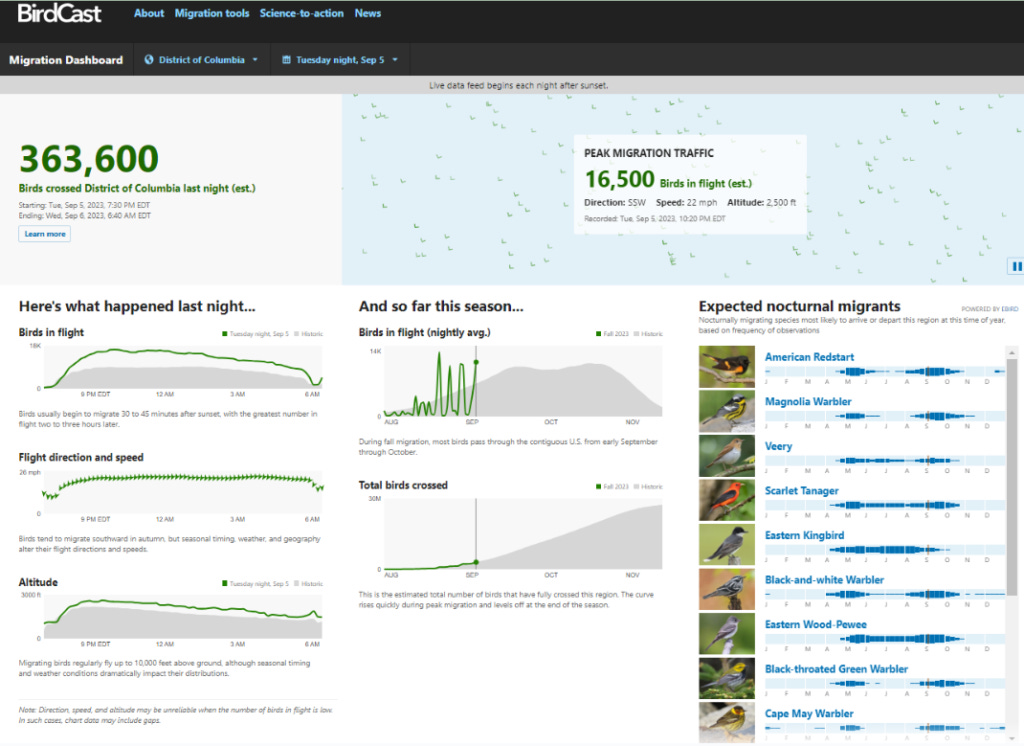
On some of the early mornings that I patrolled the many tall glass-fronted buildings along DC’s waterfront, I wouldn’t find any dead birds. Some days I would find several. These daily numbers seemed small, but compounded across the United States, around 600 million birds are killed by colliding with windows every year.1 Since 1970, the bird population in North America has fallen by 3 billion, and the hundreds of millions of deaths from window strikes are a leading cause of this decline.
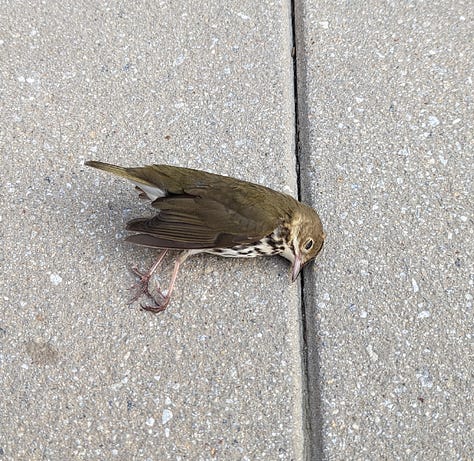
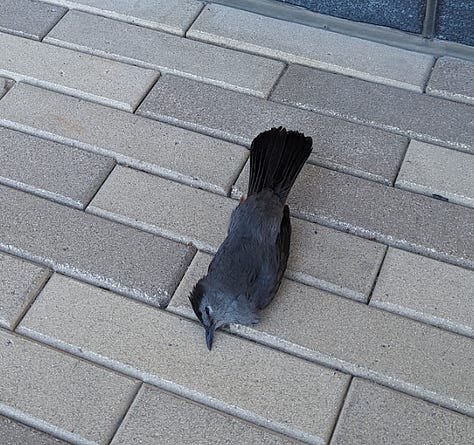
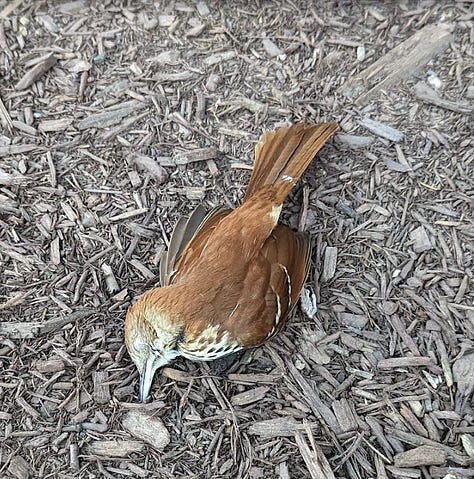
Although the scale of this destruction has grown with the expansion of cities and suburbs, our built environment — from lighthouses to telegraph lines to glass windows — has been responsible for killing large numbers of birds for at least 200 years. As fall migration is already in full swing, I wanted to look back at how the risks birds face during migration have changed over time.
Lighthouses
The earliest records I’ve found of building-driven bird mortality were of deaths caused by lighthouses, which trap birds in their beams, causing them to crash into the lanterns or circle the lights until they collapse from exhaustion. One example that feels particularly close to home was an enormous gas-powered lantern that was installed atop the US Capitol building in 1847. Until it was replaced by its current iconic dome and Freedom statue in 1866, this beacon, which was 6 feet wide and 20 feet tall, would attract “wild geese, pigeons, ducks and other species of wild fowl,” to their death each night. The Capitol police cleared from the roof of the birds each morning — presumably taking them home to eat.2
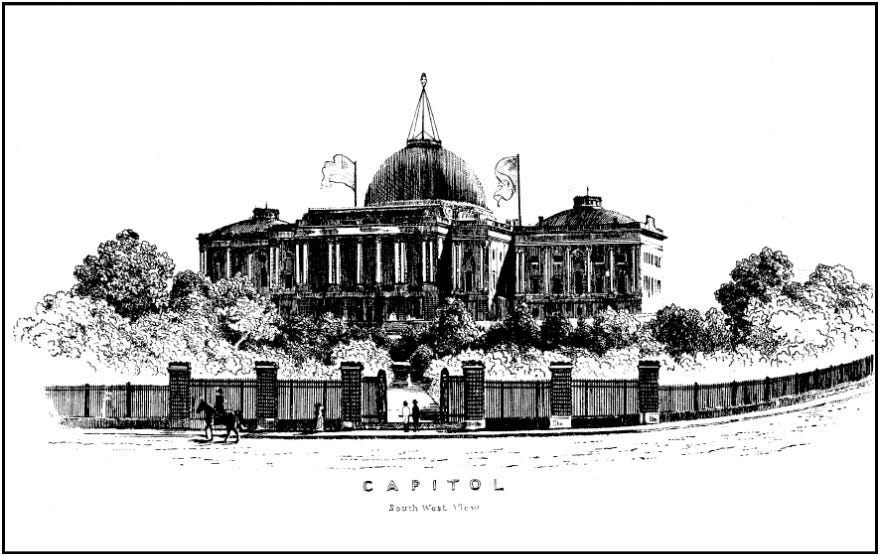
By the 1870s, ornithologists were beginning to realize that lighthouses could pose a serious threat to birds. On October 17, 1876, the naturalist Spencer Baird was stationed at the Cape Hatteras lighthouse on North Carolina’s coast, where he recorded the incredible sight of thousands of yellow-rumped warblers swarming around the lighthouse during their southward migration. Whenever the rotating light atop the tower would fall upon the birds, they would instantly streak toward the lantern, only to dash themselves against its gleaming lens. “At one time the whole element was ablaze” with birds, wrote Baird, “shining in the rays of the light like myriads of little stars or meteors.” The next morning, Baird gathered up 350 of the sparrow-sized bodies from the tower’s balcony, and found another 140 scattered about on the ground. The destruction of so many birds in just one night was not entirely a senseless waste — Baird noted that the birds “are excellent food.”3

Telegraph Wires
While the first telegraph message was sent in 1844, the technology did not become widespread until the 1860s, and it did not take long before writers noticed that woodcocks were frequently killed by flying into the overhead wires.4 In 1876, the ornithologist Elliott Coues became aware of the scale of the problem as he traveled on horseback between Denver and Cheyenne on a road that ran parallel to a telegraph line. In his first hour of riding, Coues saw three Horned Larks crash into the wire and fall to the ground, and counted more than 100 dead birds lying below the line. He estimated that this “murderous net-work over the greater part of the country” was killing hundreds of thousands of birds each year. Yet this was something that he saw as an inevitable product of modernity, writing that “since we cannot conveniently abolish the telegraph, we must be content with fewer birds. The only moral I can discern is that larks must not fly against telegraph wires.”5
Building Strikes
Although there are a handful of references to birds colliding with windows before the 20th century, the first building that attracted widespread public and scientific attention for killing a large number of birds was Philadelphia’s City Hall. When it was completed in 1894, the elegant nine-story marble and limestone edifice became the world’s tallest building. After City Hall’s dedication on July 4, 1897, spotlights began illuminating its clock tower at night, and it did not take long for dead birds to start showing up at the tower’s base. The architect and ornithologist William Baily began keeping a systematic track of the number and species of birds killed during spring and fall migration. In a process identical to that used by Lights Out DC volunteers, Bailey wrote that “each morning during the migrating periods, the tower, roofs and court below have been scoured and the specimens submitted to me for identification.”6 By October 1899, he had tallied 529 birds of 56 different species that were killed at the tower.
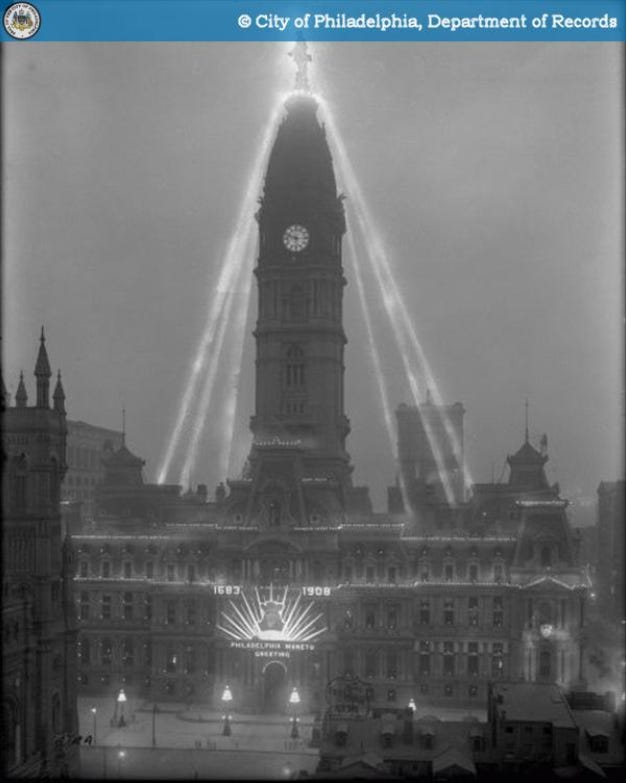
Philadelphia’s City Hall would not be America’s tallest building for long — the country was entering the age of the skyscraper, and as the buildings became taller and more glass-encrusted, they also became more deadly. The country’s most famous skyscraper quickly racked up a sobering tally of bird casualties. The Empire State Building killed hundreds of birds on major migration nights when there was high fog - over 200 were found on September 10, 1948, and over 500 on September 14, 1964.7
We also pay for our majestic national monuments in bird lives. The first count of dead birds at the Washington Monument was in 1902, when 150 birds were killed in one night. Mortality increased markedly when floodlights were installed in 1932, and ornithologists started keeping a seasonal tally of bird deaths, which peaked at 945 during the fall of 1937. The Statue of Liberty too proved to be a death trap. As far back as 1915, as many as 700 birds a month were killed by Lady Liberty’s torch when it was lit at night.8
TV Towers
Of course, it was not just buildings that migrating birds had to contend with - the conveniences of modern life called for the creation of new structures and devices whose lethality to birds far surpassed those of skyscrapers. As TVs made their way into every American household, immense TV towers, some reaching 1,000 feet tall, bloomed around the country. It did not take long for ornithologists to notice that a single tower could kill “hundreds and perhaps thousands” of birds in a single night, and the many records of high-mortality events read like reports of massacres. October 5, 1954: 1,887 birds were killed at a TV tower near Columbia, Missouri. September 19, 1958: 2,972 birds were killed at a tower in Eau Claire, Wisconsin. September 19, 1963: 1,250 were killed at a TV tower in Ostrander, Minnesota.9
Where the Deaths Are Actually Happening
Yet the great irony is that while skyscrapers and towers cause the most visible and dramatic fatality events, they are not the buildings that are most responsible for the annual death toll of 600 million birds. In fact, America’s 21,000 highrises of over 12 stories account for less than one percent of the deaths from building collisions. Instead, it is the country’s 129 million residences, which each kill two to three birds a year, and the low-rises, that each kill 20 to 30 birds a year, that are the greatest threat to birds.10
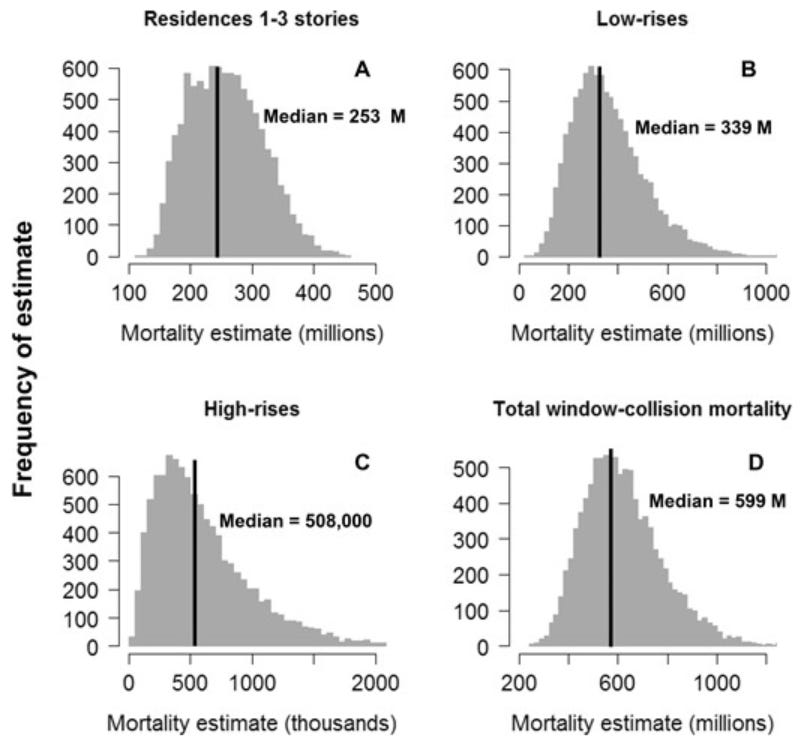
This isn’t to say that our built environment has an exclusively negative effect on birds. Skyscrapers provide ideal habitats for raptors like Peregrine Falcons to hunt, and birds clearly enjoy perching on powerlines. Yet given the degree to which we’ve altered the country’s landscape, it’s tempting to agree with Elliot Coues and say “Since we cannot conveniently abolish [houses, skyscrapers, and TV towers], we must be content with fewer birds.”
Fortunately, there are actions that we can all take to protect birds from our built environment. The easiest, lowest-cost solution is simply to turn lights off in buildings at night during spring and fall migration, which can reduce the number of bird collisions by two thirds. Buildings can also incorporate bird-safe glass into their design. UV-coated or patterned glass is much more visible to birds, and buildings renovated with bird-friendly windows have seen the number of collisions drop by 60 to 90 percent. In 2019, New York City passed a law requiring all new buildings to use glass that is more visible to birds, and Washington, DC followed their lead in 2023. I’m hopeful that these laws will continue to spread, and that more of us will decide that we would rather live in a world with more birds.
Scott R. Loss, Tom Will, Sara S. Loss, Peter P. Marra, Bird–building collisions in the United States: Estimates of annual mortality and species vulnerability, The Condor, Volume 116, Issue 1, 1 February 2014, Pages 8–23, https://doi.org/10.1650/CONDOR-13-090.1
May 22, 1886. Washington D.C. Evening Star 68(10313): 2. See also, Gas Lantern Above Capitol Building Dome Killed Wildfowl.
Harper’s Weekly, “Fascinated by Light,” March 3, 1877, Vol. 21, pg. 173. See also ALLEN, J. A. “DESTRUCTION OF BIRDS BY LIGHT-HOUSES.” Bulletin of the Nuttall Ornithological Club, vol. 5, no. 3, 1880, pp. 131–38. JSTOR, http://www.jstor.org/stable/24723046.
Elliot, D. G., 1865. “The ‘Game Birds’ of the United States.” in Report of the Commissioner of Agriculture for the Year 1864. Washington: Government Printing Office, p. 377.
Coues, Elliot. 1876, “The Destruction of Birds by Telegraph Wire.” The American Naturalist, Vol. 10 No. 12.
Bailey, William. “Migration Data on City Hall Tower.” Read before the Seventh Congress American Ornithologists Union, Philadelphia, November 14, 1899.
Avery, Michael L.., Springer, Paul F.., Dailey, Nancy S.. Avian Mortality at Man-made Structures, an Annotated Bibliography. United States: Fish and Wildlife Service, U.S. Department of the Interior, 1978.
Ibid.
Ibid.
Loss, et. al., 2014.




